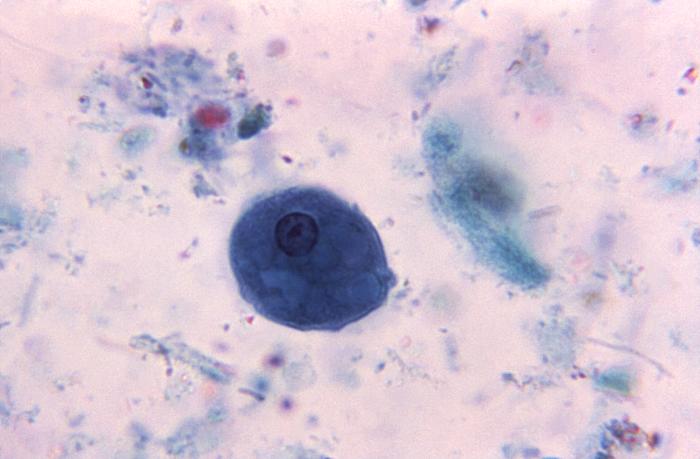The key difference between Escherichia coli and Entamoeba coli is that Escherichia coli is a harmless or pathogenic bacterial species of the genus Escherichia, while Entamoeba coli is mostly a non-pathogenic amoebal species of the genus Entamoeba.
Gut microbiota are microorganisms, including healthy bacteria. These microorganisms live in the digestive tracts of vertebrates. The alternative terms for gut microbiota are gut flora and gut microbiome. Normally, the gut bacteria represent between 300 to 100 different species. However, 99% of the bacteria come from about 30 to 40 species. Escherichia coli and Entamoeba coli are two microbial species that live in the gastrointestinal tract of humans.
CONTENTS
1. Overview and Key Difference
2. What is Escherichia coli
3. What is Entamoeba coli
4. Similarities – Escherichia coli and Entamoeba coli
5. Escherichia coli vs Entamoeba coli in Tabular Form
6. Summary – Escherichia coli vs Entamoeba coli
What is Escherichia coli?
Escherichia coli is a gram-negative, facultatively anaerobic, rod-shaped, coliform bacterium. It is a species belonging to the genus of Escherichia, which is commonly found in the lower intestine of warm-blooded organisms. Most E. coli strains are harmless, but some strains are highly pathogenic. These pathogenic serotypes include EPEC (enteropathogenic E. coli), and ETEC (enterotoxigenic E .coli), which can cause serious food poisoning in their host. Moreover, these pathogenic serotypes are occasionally responsible for food contamination incidents that prompt product recalls. The harmless strains are part of the normal gut microbiota and benefit their host by producing vitamin K2 and preventing colonization of the intestine with pathogenic bacteria. E. coli is expelled into the environment within fecal matter and grows massively in fresh fecal matter.

Figure 01: Escherichia coli
The fecal oral route is the major transmission route for the pathogenic strains of E. coli. The cells of this bacterial species are able to survive outside the body for a limited amount of time. This makes them potential indicator organisms to test environmental samples for fecal contamination. Furthermore, E. coli is the most widely studied prokaryotic model organism, and it is an important species in fields such as biotechnology and microbiology. This is because it has served as the host organism for the majority of work with recombinant DNA technology.
What is Entamoeba coli?
Entamoeba coli is a non-pathogenic species of the genus Entamoeba. It frequently exists as a commensal organism in the human gastrointestinal tract. This species is very important in medicine because it can be confused during microscopic examination of stained stool samples with pathogenic Entamoeba histolytica. This species has three distinct morphological forms airing in their life cycle, including trophozoite stage, pre cystic stage, and cystic stage.

Figure 02: Entamoeba coli
This amoeba species does not move much by using its pseudopod. It creates a “sur” place movement inside the large intestine. But amoeba is usually immobile and keeps its round shape. In its trophozoite stage, this amoeba is only visible in fresh, unfixed stool specimens. Sometimes, within this species, parasites like the fungus Saphaerita spp. can be found. This fungus lives inside the cytoplasm of the Entamoeba coli. Though it is a harmless species, it can cause internal bleeding in some situations.
What are the Similarities Between Escherichia coli and Entamoeba coli?
- Escherichia coli and Entamoeba coli are two microbial species that live in the gastrointestinal tract of humans.
- Both are single-celled species.
- These species can be designated as E .coli.
- Both species can be commensal or harmless.
What is the Difference Between Escherichia coli and Entamoeba coli?
Escherichia coli is a harmless or pathogenic bacterial species of the genus Escherichia while Entamoeba coli is mostly a non-pathogenic amoebal species of the genus Entamoeba. Thus, this is the key difference between Escherichia coli and Entamoeba coli. Furthermore, Escherichia coli is a prokaryotic species, while Entamoeba coli is a eukaryotic species.
The below infographic presents the differences between Escherichia coli and Entamoeba coli in tabular form for side by side comparison.
Summary – Escherichia coli vs Entamoeba coli
Escherichia coli and Entamoeba coli are two microbial species that live in the gastrointestinal tract of humans. Escherichia coli is a harmless or pathogenic bacterial species of the genus Escherichia while Entamoeba coli is mostly a non-pathogenic amoebal species of the genus Entamoeba. So, this is the key difference between Escherichia coli and Entamoeba coli.
Reference:
1. “Entamoeba Coli.” An Overview | ScienceDirect Topics.
2. “E. Coli (Escherichia Coli).” Centers for Disease Control and Prevention, Centers for Disease Control and Prevention.
Image Courtesy:
1. “Koli-bacteria-escherichia-coli” (CC0) via Pixabay
2. “Entamoeba Coli trophozoite” By Yasser from Cairo – Entamoeba Coli trophozoite (CC BY 2.0) via Commons Wikimedia
ncG1vNJzZmivp6x7pbXFn5yrnZ6YsqOx07CcnqZemLyue9ahmK1lmah6tbTEZpuinpaav6a6wp5km52krLKmuoyeqpyglae2pLTImmScp5yeeqK6w2acp6yRorymrsBmmqikmWQ%3D